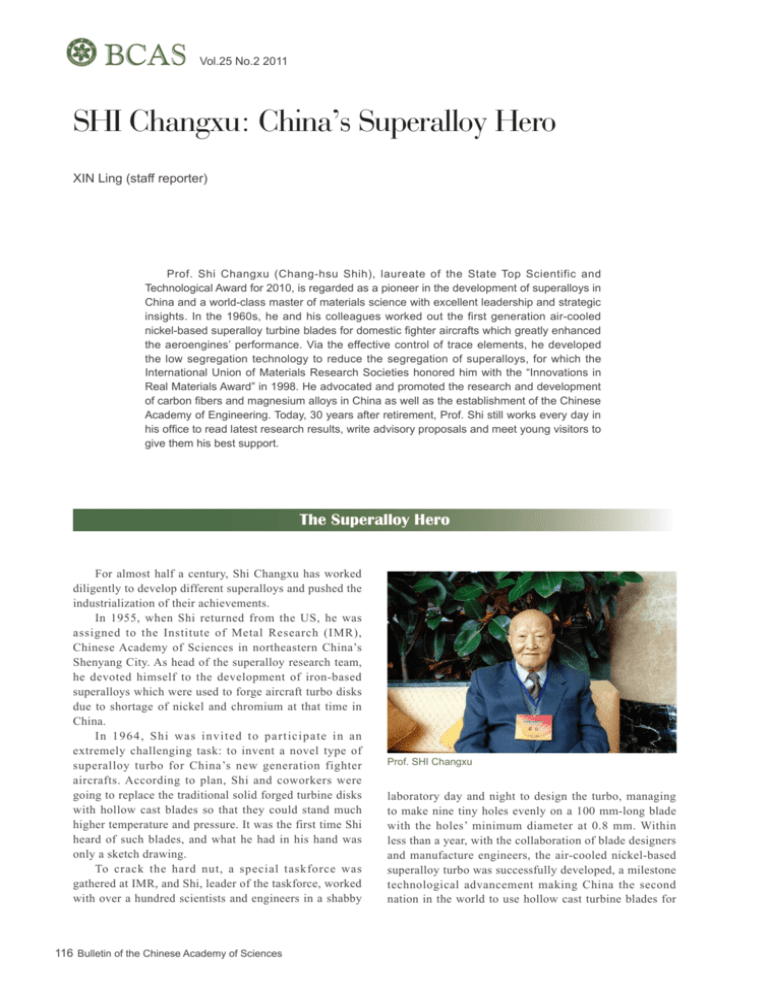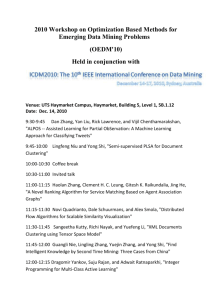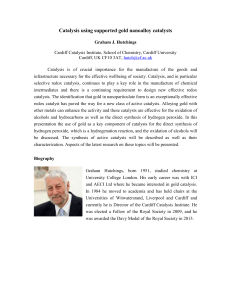SHI Changxu: China's Superalloy Hero
advertisement

BCAS Vol.25 No.2 2011 SHI Changxu: China’s Superalloy Hero XIN Ling (staff reporter) Prof. Shi Changxu (Chang-hsu Shih), laureate of the State Top Scientific and Technological Award for 2010, is regarded as a pioneer in the development of superalloys in China and a world-class master of materials science with excellent leadership and strategic insights. In the 1960s, he and his colleagues worked out the first generation air-cooled nickel-based superalloy turbine blades for domestic fighter aircrafts which greatly enhanced the aeroengines’ performance. Via the effective control of trace elements, he developed the low segregation technology to reduce the segregation of superalloys, for which the International Union of Materials Research Societies honored him with the “Innovations in Real Materials Award” in 1998. He advocated and promoted the research and development of carbon fibers and magnesium alloys in China as well as the establishment of the Chinese Academy of Engineering. Today, 30 years after retirement, Prof. Shi still works every day in his office to read latest research results, write advisory proposals and meet young visitors to give them his best support. The Superalloy Hero For almost half a century, Shi Changxu has worked diligently to develop different superalloys and pushed the industrialization of their achievements. In 1955, when Shi returned from the US, he was assigned to the Institute of Metal Research (IMR), Chinese Academy of Sciences in northeastern China’s Shenyang City. As head of the superalloy research team, he devoted himself to the development of iron-based superalloys which were used to forge aircraft turbo disks due to shortage of nickel and chromium at that time in China. In 1964, Shi was invited to participate in an extremely challenging task: to invent a novel type of superalloy turbo for China’s new generation fighter aircrafts. According to plan, Shi and coworkers were going to replace the traditional solid forged turbine disks with hollow cast blades so that they could stand much higher temperature and pressure. It was the first time Shi heard of such blades, and what he had in his hand was only a sketch drawing. To crack the hard nut, a special taskforce was gathered at IMR, and Shi, leader of the taskforce, worked with over a hundred scientists and engineers in a shabby 116 Bulletin of the Chinese Academy of Sciences Prof. SHI Changxu laboratory day and night to design the turbo, managing to make nine tiny holes evenly on a 100 mm-long blade with the holes’ minimum diameter at 0.8 mm. Within less than a year, with the collaboration of blade designers and manufacture engineers, the air-cooled nickel-based superalloy turbo was successfully developed, a milestone technological advancement making China the second nation in the world to use hollow cast turbine blades for Vol.25 No.2 2011 aeroengines, only five years later than the US. “The responsibility and pressure was no doubt heavy on me,” Prof. Shi recalled with a smile, “but I believe in painstaking work – since US colleagues have succeeded, we can make it too.” When the blades were put into operation in 1966, they proved to meet all technical requirements and elevated the turbo’s inlet air temperature by some 100 °C. “They haven’t led to a single fight failure or accident over these years, and are still used on the best flight aircrafts in China today,” the professor noted proudly. Besides the superalloys for military and civilian People use, Shi’s group also worked out corrosion resisting superalloys and alloy steels for utility gas turbine and urea production facilities, high-strength alloy steels for making industrial furnaces and submarine masts, as well as alloy steels that can resist magnetization and extreme temperatures. Under Shi’s leadership, the CAS Institute of Metal Corrosion and Prevention (now a state key laboratory affiliated to IMR) was founded in Shenyang in 1982, and a national network on material environmental corrosion was set up to accumulate scientific data for the study and application of materials science. A Strategic Scientist After serving at IMR for about three decades, in the spring of 1984, Prof. Shi moved to Beijing to chair the Academic Division of Technological Sciences at CAS headquarters. Two years later, he was appointed deputy director of the newly established National Natural Science Foundation of China (NSFC). Shi was actively involved in the groundbreaking work for the early growth of NSFC. He won over 2% funds of the “State High-Tech Research and Development Program” for NSFC to support scientific studies with novel notions or concepts. With the fund, from 1986 to 2000, some 200 million RMB were earmarked for over 2,000 research programs that cultivated new technologies and young scientists. He participated in the drafting of the National Long-term Development Outline for Science and Technology in 1988 and chaired the plan of the New Materials program in 1983. He not only presided over the compilation of the first “Guide for NSFC Programs” and the strategic development plans for over 50 disciplines, but promoted the publication of “Science Foundation in China” and “Progress in Natural Science” to provide a communication platform for scientists and Foundation officials. As a bold organizer and strategic scientist, Shi has a broad scientific vision focused on but not limited to superalloy study. In fact, his insights into the strategic development of many other materials have proved sagacious. Carbon fibers are strong, light and expensive fibers that have a wide application in aerospace and automobile manufacturing. Due to their massive military use, the sale and technological transfer of carbon fibers are prohibited to China. Chinese scientists began to study polyacrylonitrilebased carbon fibers in 1962, but saw no substantial development progress throughout the following decades. In 2000, at the bottom of carbon fiber development in China, eighty-year-old Shi decided to take up the challenge and save the situation. “First we have to call in experts and Prof. SHI (3rd from right) conducting a survey of enterprises. spell out the existing problems”, he told a high official of NSFC. Based on the major reasons for the failure of carbon fiber industry in China which were identified during an expert meeting in August, 2000, Shi and his colleagues handed in a development proposal to relevant government departments. Next January, Shi wrote a letter to then President JIANG Zemin, asking to boost the research and development of high-performance carbon fibers in China. With Shi’s untiring promotion and coordination, in October, 2001, a special program was set up by the Ministry of Science and Technology for carbon fiber study. Since then, more and more projects on carbon fibers have received funds from NSFC and the central government, and China has achieved remarkable advances in carbon fiber industry. Some domestic manufacturers have started massive production, which broke the monopoly of developed countries like Japan and the US. Shi emphasizes academic cooperation. In 1986 he established the Chinese Materials Union, which became Chinese Materials Research Society (CMRS) in 1991. He also attaches great importance to the development of biomedical materials in China, seeing it as a vital Bulletin of the Chinese Academy of Sciences 117 BCAS Vol.25 No.2 2011 undertaking for the health of 1.3 billion people. Thanks to his coordination efforts, the Chinese Committee for Biomaterials was established in 1997. In 2004, he led a Chinese delegation to win the bid for the 9th World Biomaterials Congress which will be held in southwest China’s Chengdu in June, 2012. “Patriotism, My Unfailing Faith” Prof. Shi in his nineties is still energetically working at the frontier of materials science and industry. In 2010, he went on almost a dozen of trips, attending conferences and visiting organizations from the northeastern city of Harbin to the southmost provincial capital of Guangzhou. “If you ask what’s pushed me moving on and on, I’d say it’s the love of my nation, and the faith that China must be strong – from I was a kid.” Born in a literary family in a village of north China’s Hebei Province in 1920, Shi Changxu lived a quiet but happy childhood in the backyard of his 40-member extended family, enjoying reading alone and getting to know the chaos in the outside world. “As a primary school student I was by no means clever, but I managed to make it up with diligence.” Years later, the Japanese invasion shattered Shi’s plan of becoming a primary school teacher to support his family after graduation, and he had to flee home like a refugee to avoid the press gang. When he went through all kinds of hardships and was finally admitted to the National Northwestern Engineering College in south of Shaanxi Province , he chose to study metallurgy because “at that time many young people believed they can save the nation by engaging in industry”. The war left a deep scar on Shi’s heart, driving him to a life- long conviction – to love his country, and do everything he can to make his country strong. Shi graduated from Northwestern Engineering College as one of the top students, and worked two years before he acquired a chance for further education in the US. From 1948 to 1952, Shi Changxu first studied metallurgy at University of Missouri and then obtained a PhD degree from the University of Notre Dame. After the foundation of “Red China” and the outbreak of the Korean War, about 5,000 Chinese students including Shi Changxu were held by the American government and not allowed to go home. Shi had no choice but to work as a research associate at MIT for the time being. But he had never given up the intent to come home and organized several attempts to reveal the obstruction of the US government. In 1955, days before Shi Changxu was to return China, his supervisor Prof. Morris Cohen at MIT asked if it was the position or money problem that would take away one of his favorite students. “No, professor. It’s only because compared with the US, my motherland now needs me more,” Shi answered. “The love is here in my heart, and it will never fade away,” Prof. Shi’s wrinkled but determined face makes him look so gracious. The “Beauty Heart Radish” Gentle, helpful and modest: Prof. Shi has been an inspiring figure to all who knew and worked with him. They even gave him a nickname – the “beauty heart radish”, a local vegetable they all like to eat. “The professor has a beautiful mind that never envies or resents. He respects everybody and treats them equally,” says Prof. LI Yiyi, who is a former student of Prof. Shi at IMR and now a senior researcher and CAS member. “The distance between his house and his office in Shenyang was no more than 200 meters, but he often spent more than half an hour on the way because many colleagues and workers came up to chat with him.” When Li began to work as the academic secretary of Prof. Shi’s research laboratory in 1964, she found her leader very modest and gave her enough space to carry out her duties. “The professor always supports our new ideas even it’s a bad one, so it’s very pleasant and comfortable to work with him.” 118 Bulletin of the Chinese Academy of Sciences According to YUAN Haibo, an ex-secretary-general of NSFC, “kindness is the quality that impressed me most during the 20-odd years I worked with him. Wherever he was, his kindness and leadership can naturally draw people around and connect all forces to achieve success.” Yuan admired Prof. Shi’s rigorous scholarship. He remembered once he handed in the Collection of Scientific and Technological Research Outcomes for Prof. Shi to read through. To his surprise, the professor proofread the papers paragraph by paragraph, including the English titles of each research program. Despite his age, Shi now still writes nearly all reports and speeches by himself. In his memoirs Prof. Shi wrote, “A man shall first set a proper outlook on his life and contribute to the human society. As a Chinese we must make contributions to our country, that’s all that matters to me.” Vol.25 No.2 2011 People Approaching the Secret of Catalysis —— Chemical physicist LI Can’s pursuit SONG Jianlan (staff reporter) On July 16, 2004 at the 13th International Congress on Catalysis (ICC) in Paris, Prof. LI Can received the International Catalysis Award from Prof. Michele Che, President of the International Association of Catalysis Societies (IACS), and became the first scientist from the developing world to win this honor. Also at this conference, Li was elected Vice President of IACS, which automatically put him into the position of IACS President four years later in 2008. The International Catalysis Award, which is deemed to be the highest of catalysis science, is an honor given by IACS to recognize internationally outstanding achievements in the field. Only one nominee who is supposed to be under age 45 could be crowned with this prize every four years. Li, a chemical physicist renowned for his contributions to catalytic materials, catalytic reaction and catalytic characterization research, is the first in the world to have successfully applied UV Raman spectroscopy to catalysis and materials research. His smart strategy to collect Raman spectra in the UV region can effectively bypass the interference from fluorescence mostly occurring in visible region, and meanwhile greatly improve the sensitivity of detection via UV resonance Raman Effect, benefiting from the shorter wavelengths of the excitation laser in this region. Breaking a major bottleneck barrier, his invention of UV Raman Spectrograph has made possible a series of important breakthroughs in fundamental catalysis research. Li has kept in the spotlight over the past few years: Prof. Li gives a 60-minute lecture titled “Catalysis in microand meso-pore: UV Raman identification of active sites and confinement effects in chiral synthesis” at the awarding ceremony of the 13th ICC. he was elected a Foreign Member of Academia Europaea in 2008, a Fellow of Royal Society of Chemistry and a Member of the Academy of Sciences for the Developing World (TWAS) in 2005 and a Member of the Chinese Academy of Sciences (CAS) in 2003. It is not easy to conceive, however, that Li has got to this height of academic fame from a remote village on the Hexi Corridor of China, also commonly known as Hosi Corridor; and he almost lost the opportunity to pursue any academic career. Obscure Origin Born in a farmer’s family of Yongchang County, Gansu Province in 1960, Li spent his childhood with great hardship. In 1976 when he finished his high school, no access to any higher education was available amid the ruins left behind by the so-called “Cultural Revolution.” Fortunately he did not wait too long to see the dawn. On a big day of 1977, the former president of his high school personally rode a long way to Li’s village to inform him with the resuming of the National University Entrance Examination, a merit-based recruiting system for colleges and universities which was, and still is the only practical pathway for students of a minor origin to go to colleges. The old president deemed Li as the most intelligent student in his school and thought it would be a great pity if Li missed the bus. Bulletin of the Chinese Academy of Sciences 119 BCAS Vol.25 No.2 2011 In the year of 1978, Li got the admission to the Department of Chemistry at the Zhangye Normal Institute, the nowadays Hexi University in Zhangye City of Gansu Province. He cherished this hard-earned chance and spared no efforts to improve his academic know-how in chemistry. His diligence kept him so excellent a student that he had scarcely graduated when the Institute employed him as a teacher. A year later he obtained an opportunity to study at the Shannxi Normal University, where his enthusiasm for catalysis research was triggered by a paper entitled Atomic Clusters in Relations to Catalysis and Surface Sciences by Prof. ZHANG Dayu, a renowned scientist from the Dalian Institute of Chemistry and Physics (DICP) under CAS, and decided to pursue research in this field. This passion for catalysis research has never withered away. “Catalysts can have magical effects on chemical reactions. This phenomenon itself is intriguing, and it would be great fun to unveil its secret. Moreover, its vital role in building human society has also fueled me with enduring interests,” Li remarks when asked what has driven him all the way through thick and thin over the past decades in catalysis research. This very enthusiasm guided him to another turning point in the year 1983: Li passed the entrance exam and was admitted as a postgraduate student at the DICP. This lent him a stepping stone to the sanctum of science. Early Research When he was pursuing his PhD at DICP, Li met with Prof. Takaharu Onishi from the Tokyo Institute of Technology (TIT), a well renowned catalysis expert in Japan, who was then visiting DICP and appreciated Li’s research very much. Before long, with Prof. Onishi’s recommendation, Li attained a UNESCO scholarship to study at the TIT for one year, in the capacity of a PhD candidate jointly trained by DICP and TIT. At TIT, Li conducted a systematic study on the surface properties and catalytic mechanisms of rare-earth cerium oxide, the vital component of catalysts for removing pollutant gases from vehicle exhausts. During this period, he published eight papers in international journals including J.Am.Chem.Soc. Some of these papers have become fundamental literature for subsequent studies on the threeway catalysts for reducing exhaust pollutants. After finishing his work in Japan, Li came back to DICP and began to build up his own research laboratory/ group in China. In 1989, Li won the financial support from the “Youth Scientist Foundation,” a newly established foundation under the National Natural Science Foundation of China (NSFC). “It was the first independent project I have ever gained. The funding timely met my urgent needs and greatly refueled my enthusiasm. At that time 50,000 yuan was a big sum of money; it would allow me to concentrate on research in the following three years without financial worries,” Li reviews with appreciation. The following three years proved to be rewarding. Li made a series of breakthroughs in the research on oxidation and activation of methane. By the aid of isotope labeling and high- and low-temperature in situ spectroscopic technique, he successfully characterized a series of oxygen species, including peroxide, superoxide and their transition mechanisms and catalytic activity; he also observed the active species of adsorbed methane on catalysts, particularly the distorted structure of adsorbed methane induced by active oxygen species on the surface of catalysts. As a result, his work was rewarded with the CAS Natural Science Awards of 1993 when he was promoted to a full professor in DICP and became one of the youngest professors in the institute. UV Raman Spectroscopy The in situ characterization of catalysts is a fundamental basis of catalysis science, and Raman spectroscopy is thought to have great potential in this field. However, application of Raman spectra to scientific research was once seriously hindered by strong fluorescence interference, making this issue an important but challenging subject of catalysis science. When performing a visiting research program in 1995 at Northeastern University in USA, Li and 120 Bulletin of the Chinese Academy of Sciences his American colleagues made some initial progress in this realm. When he went back to China, Li won the support from the NSFC “Outstanding Young Scientist Foundation” in 1996 and formally launched a project to develop a UV Raman Spectroscopy for catalysis researches, inspired by his team’s discovery that obtaining Raman spectra of some different kinds of catalysts in the UV region can effectively bypass the fluorescence inference. Based on this strategy Vol.25 No.2 2011 they invented the first set of UV spectrograph in China for catalysis in situ observation and characterization. Because of the shorter wavelengths and the possibility to obtain UV resonance Raman Effect in the UV region, this technique can greatly improve the sensitivity of detection. This invention has since led to a series of great advances in this field of research. In the subsequent years, Li’s research team successfully applied this new technology to catalysis research, and made progress in in situ characterization of catalysts and catalytic active sites with their different species, like the coke deposition on catalysts, synthesis of molecular sieves, transition metal-substituted molecular sieves and phase transformation of oxide catalysts. In particular, their work on identifying the transition metal atoms incorporated in molecular sieves have received special attention from the international catalysis community, being seen as a most reliable method to identify the highly isolated active sites in zeolites. Li’s work on UV Raman Spectroscopy and related discoveries were also highly recognized in China: the UV Raman spectrograph and the spectroscopic study on catalysts won a National Award for S&T Inventions in 1999. People and immobilization of chiral homogeneous catalysts (e.g., Sharpless and Mn(salen) complexes) into mesoporous materials through organo-inorganic hybrid and chemical grafting. This work has led to a significant improvement of the enantioselectivity of heterogeneous catalysts for the chiral epoxidation of olefins in the pores, and chiral hydrogenation of ketenes. His persistent pursuit earned him the International Catalysis Award. Li and his team have developed a series of heteropolytungstate oxidation catalysts and a green, ultra-deep desulfurization process, based on an oxidation-extraction approach. This technology is capable of cutting the sulfur content from several hundred-ppm ranges down to only a few ppms. This work was highlighted by the Green Chemistry in 2004, and is now under pilot test in SINOPEC. Prof. LI and his colleagues have developed a UV Raman spectroscopy technique for in situ characterization of catalyst phase structure. Shown here is the surface phase transformation of TiO2 observed by UV Raman Spectroscopy, which is more sensitive at the surface region than in the bulk of the metal oxide. Based on the above technology, Li and his team made several other achievements, including the successful synthesis of novel catalysts for selective oxidations incorporated with atomically isolated transition metal ions Prof. Li at his laboratory High-efficiency Production of Hydrogen via Solar Light Apparently Li has never contented with his own achievements. He has been focusing on another challenging and long-term subject since 2001: to raise the efficiency of hydrogen production powered by solar light. Ways as cheap and effective as photosynthesis to transform solar energy into more convenient forms of chemical energy, like Bulletin of the Chinese Academy of Sciences 121 BCAS Vol.25 No.2 2011 storable hydrogen, represent an unconquerable pinnacle for science, and a long-harbored dream of humankind. Li has focused his attention to photocatalytic production of hydrogen from water using solar energy. He dreams of developing novel photocatalysts with low-cost and highefficiency to convert solar energy to solar fuels and solar electricity. Li’ team has made great efforts in solar energy research including photocatalytic material synthesis, photocatalyst characterization and photocatalysis mechanism understanding. Recently the team saw progress in their work on cocatalyst and developed a type of Pt-PdS/CdS three-component photocatalysts, based on Li’s strategy of dual cocatalysts. In 2009 the team achieved a quantum efficiency of 93% in their experiment using Na2S as sacrifice. This marked the highest that time in the field. Actually this efficiency approaches that of the initial photosynthesis progress in nature. Before Li’s work, the highest quantum efficiency in photocatalytic hydrogen production was about 60%. “We could not believe our eyes at first,” Li recollected when talking about their encouraging progress, with a radiance of happiness: “we were not reassured until this efficiency was frequently reproduced in our subsequent experiments and in other laboratories.” Li’s work is thought to have opened a new way to design high-efficiency artificial photocatalysts. It also provides a green, energy-saving technology to transform 122 Bulletin of the Chinese Academy of Sciences Li talking with students pollutants like hydrosulfide, and meanwhile to produce hydrogen. It has promising future and the team is making pilot experiments for its industrial application. “Catalysis keeps producing substantial techniques for the economic development of human society with its magical efficacy,” Li introduces when talking about the great importance of catalysis research: “Actually it sits at the core of chemistry and deserves lifetime pursuit.” Continuing his catalysis research, Li lives a simple but productive life, busy every day reviewing literature, thinking over research approaches and discussing with students. “Actually,” Li remarks: “this peaceful and plain lifestyle is the biggest pleasure for me.”







